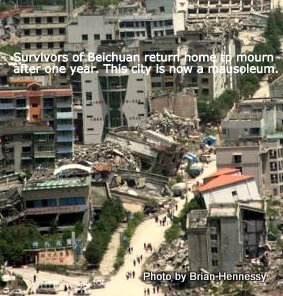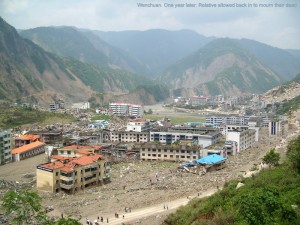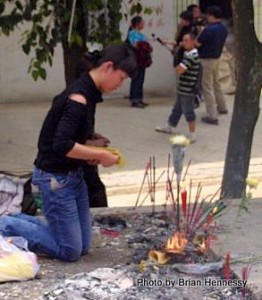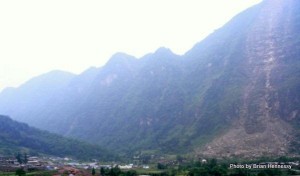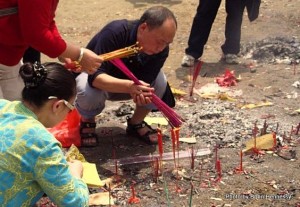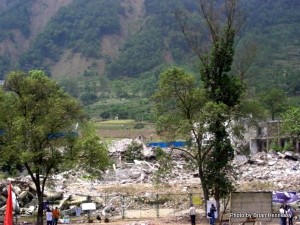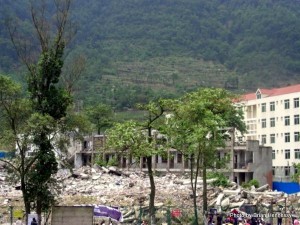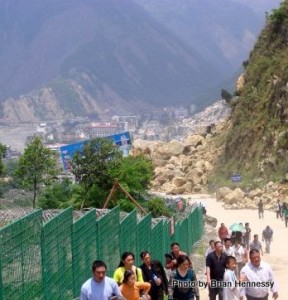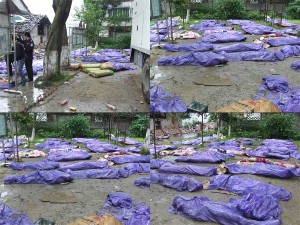Sichuan earthquake. Beichuan. One year later.
Brian Hennessy. China Australia Consult. 5:12 (2009).
My purpose here is to outline what I saw at the epi-center of the earthquake one year after that terrible day. A day when relatives were allowed back into what is left of that city to grieve. Until now, nobody has been allowed to return. Beichuan is beyond saving. There will be no reconstruction.
Earthquake. Beichuan. One year later
______________________________________________________________
My petty, useless words are not up to the job of describing the devastation the Sichuan earthquake wreaked on the picturesque valley-town of Beichuan and its citizens.
This place of death and terrible beauty. This idyll of green steep sloped mountains and small river-valleys, cosseted inside the high fractured edge of a mobile Tibetan Plateau. Once a thriving community, now a mausoleum.
This is the fault-line. This is where the eastward motion of the Plateau bumps into stable bedrock under the fertile Sichuan basin.
Most of Beichuan's citizens are buried in the rubble of collapsed buildings or under the mud and stone of the avalanches which followed the initial shock.
The first sad sight is the remains of Beichuan Middle (high) School. An ugly pile of shattered slabs of concrete. Little evidence of metal reinforcing extruding from the edges. Hard to believe that 700 students died here in seconds. 300 bodies recovered, 400 interred forever under the rubble in front of me.
Family groups grieving in an adjacent special place reserved for flowers and the burning of incense and paper money. I place my own flowers here.
A young lady in a quiet corner burning paper money for her lost relatives – ritual help for their souls as they journey to the afterlife.
An older woman lighting incense beside me. Quietly bereft. Who has she lost? How many has she lost? She looks at me. What can I do? I put my arm around her shoulders as she draws close to me and releases a few muffled sobs. ‘Xiexie pengyou’ (thankyou friend) she says before withdrawing into herself again. Chinese containment of emotion.
I walk further into the valley. A valley that was isolated from the rest of China by buckled roads and landslides for days before help arrived. Soldiers had to parachute into this disaster.
I look up. Ugly gashes scarring the the almost vertical green mountainsides where sections lost their grip and and collapsed into the valley below. You can track the path they took as they hurtled down through the natural gullies and small ravines: filling them to the brim before overflowing and thundering across the valley floor. Crushing the life out of the place.
Some relatives lighting fireworks amid the rubble. Warding off any bad spirits, preparing the way for the release of the souls of the deceased. Others discovering a place where a house used to be. Grieving for lost ones entoumbed beneath their feet. Families reunited in suffering as the awful realisation of how their loved ones died hits them. Expressing their sorrow with as much dignity as they can manage.
Truly incredible people. Trying to absorb this scene of horror around them and underneath their feet. I defy anyone to remain dry-eyed in such a situation.
Chinese people. Used to suffering. A Government responding quickly, then pouring aid and infrastructure into the surrounding district. Doing the right thing.
Refugee camps. Too many of them. Peopled by an uncomplaining, accepting, resilient local population.
Beichuan Middle School campus.
1000 students out of an enrollment of 2793 died here.
400 remain buried underneath the rubble.
Relatives walking back from the ruins of Beichuan
Temporary camp
Beichuan Middle School students
.

